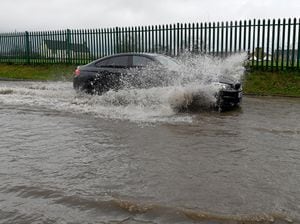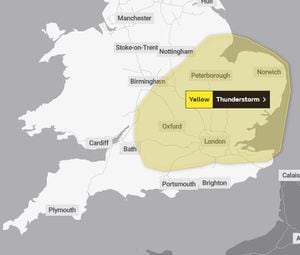Driving in storm advice as Met Office issues eight-hour thunder warning
Thunderstorms are forecast to reach the West Midlands as temperatures drop from the record-breaking heat seen on Tuesday.

For the first time ever, the temperature reached 40C in the UK with 40.2C recorded at Heathrow, while numerous other locations in London and the South East all topping 39C and beating the previous record of 38.7C from 2019.
The Met Office has now issued a yellow thunderstorm warning for many of the places covered by the red and amber extreme heat warnings put in place earlier this week.
The eight-hour warning runs from 1pm-9pm on Wednesday, reaching parts of the West Midlands and Worcestershire, while heavy downpours have been reported in north Shropshire.
"Heavy showers and thunderstorms may bring disruption during Wednesday afternoon," they Met Office said in its warning.
"Heavy showers and thunderstorms are expected to develop across central, southern and eastern parts of England on Wednesday afternoon. Whilst most places will see only small amounts of rain there is a chance of some isolated heavy downpours and lightning. Where these occur a few sites could see 20-30 mm in an hour and 50 mm in three hours.
"Forecasters are also warning: "Spray and sudden flooding could lead to difficult driving conditions and some road closures."
"There is a slight chance that power cuts could occur and other services to some homes and businesses could be lost."
For those who are set to drive into areas forecast to be hit by storms, the Met Office has published advice on driving in storms, rain and strong wind.

"Even moderate rain can reduce your ability to see and be seen," it says. "A good rule of thumb is ‘if it’s time for your wipers, it’s time to slow down’.
"If heavy downpours are expected, avoid starting your journey until it clears. If you can, choose main roads, where you are less likely to be exposed to fallen branches and debris and flooding.
"Roads will be more slippery than usual in wet weather – be sure to give yourself more time to react when approaching a hazard. Increase your following gap to at least four seconds from the moving traffic in front.
"Keep your eyes peeled on the road at all times as spray from other vehicles can suddenly reduce your visibility. Remember it affects others too, so anticipate their actions and be prepared."
National Highways has also published advice, telling road users that the wet weather reduces grip and visibility, two things thatsignificantlyly increase the chances of being involved in a collision'.
The agency warns drivers that stopping distances "will be at least double in wet weather", advising them to "keep well back from the vehicle in front" in order to increase visibility and the ability to plan ahead.
"Ease off the accelerator and slow down gradually if the steering becomes unresponsive as it probably means that water is preventing the tyres from gripping the road," the advice continues.
The Met Office says to turn around and find another route if you come across a flooded road, describing driving through flood water as the "number one cause of death during flood".
"Although the water may seem shallow, just 12 inches (30cm) of moving water can float your car, potentially taking it to deeper water from which you may need rescuing," the agency warnings.
"Flood water also contains hidden hazards which can damage your car, and just an egg-cupful of water sucked into your car’s engine will lead to severe damage.
"Never drive through flood water. Turn around."





